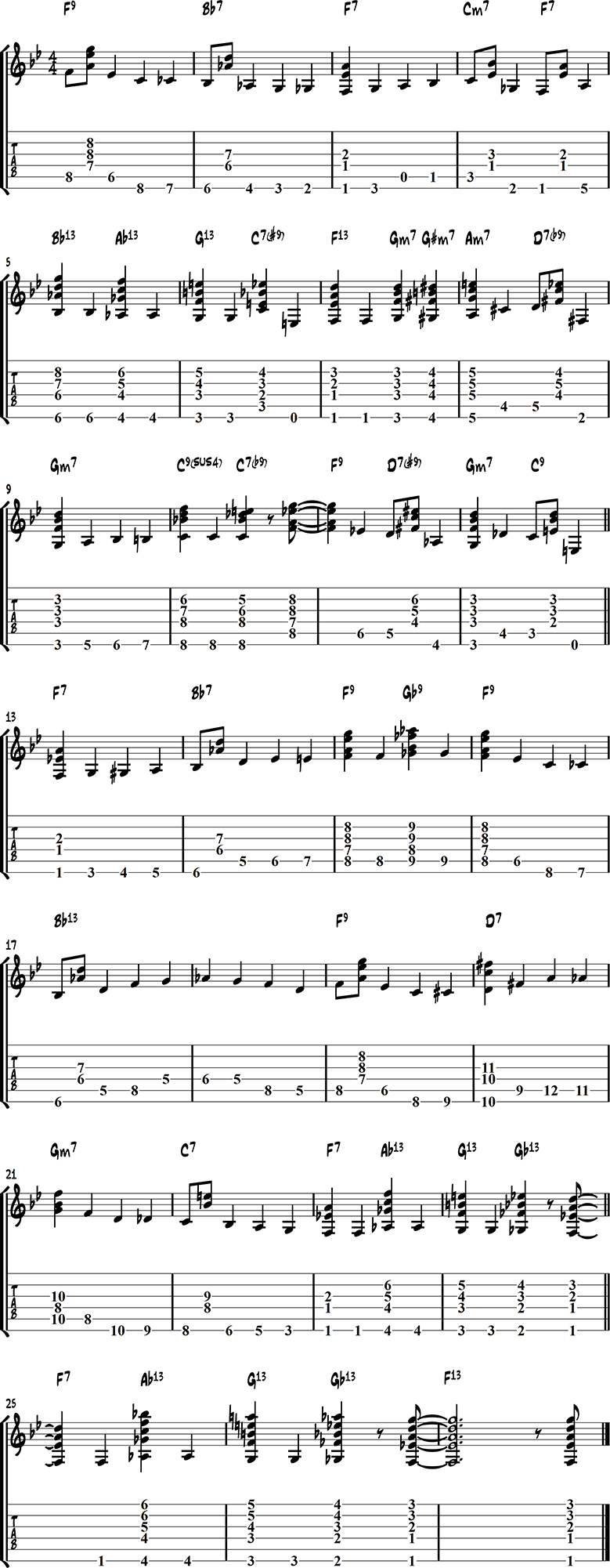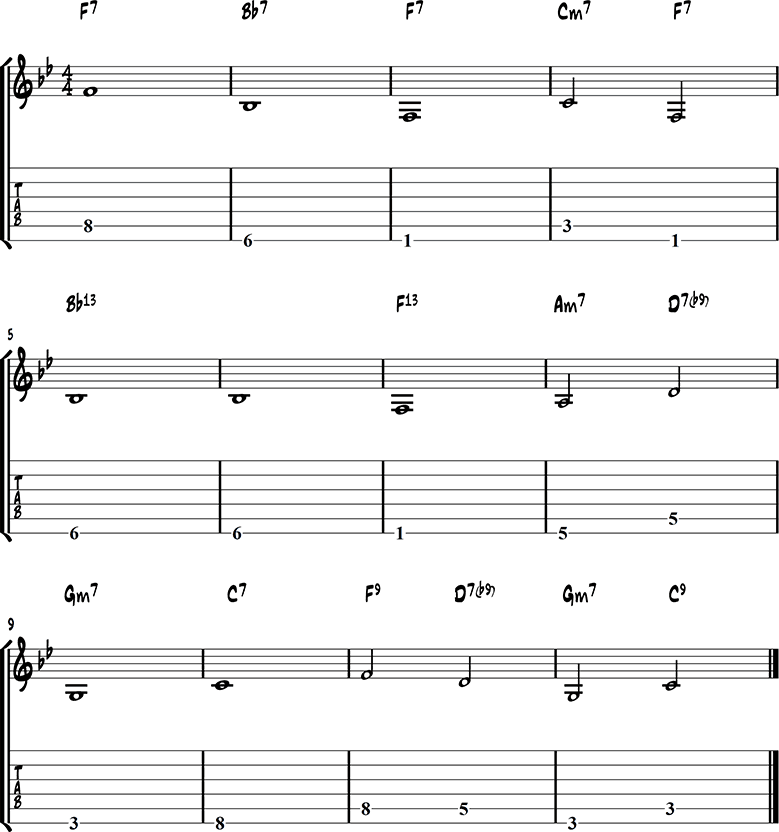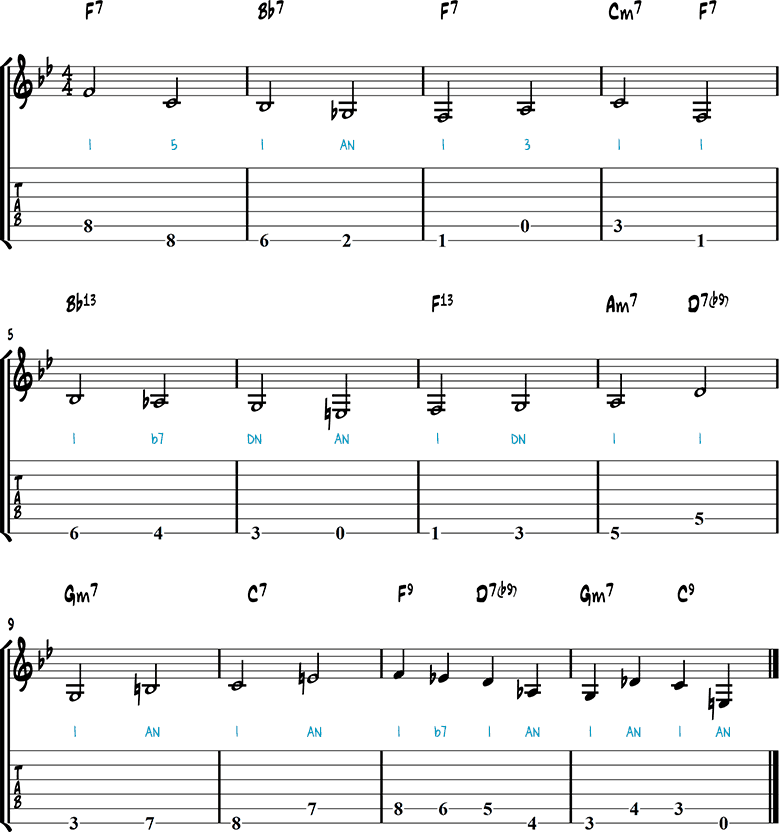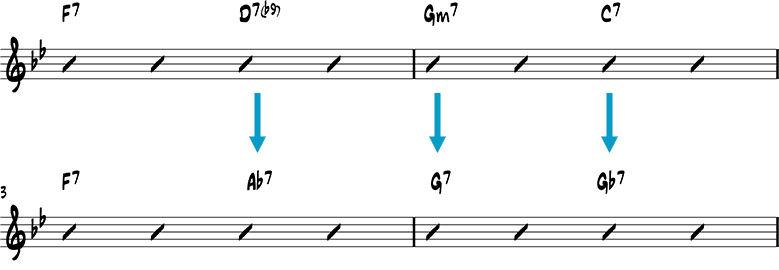Id Love You All Over Again Guitar Chords
In this lesson, you will learn how to combine chords with a walking bass line, a concept that is becoming more and more than in demand these days. Every bit gild and eating place owners are cutting budgets, one mode to keep our gig equally a guitar actor is to slim down the ensemble to a duo or solo.
A walking bass line walks through the chord progression, one note per crush. Its function is to outline the chords of the progression and provide a smoothen transition from 1 chord to another.
While walking bass in a band is generally played by the bass guitar or double bass role player, being able to play walking bass lines is an essential skill for jazz guitarists when playing without a bass player.
The difficulty in walking bass on the guitar lies in the combination of playing chords and bass at the same time.
Walking bass on guitar is usually played fingerstyle. Use your pollex for the bass notes and your other fingers to comp the chords.
In this lesson, you lot will learn how to write and play a walking bass line over a 12-bar blues in F.
Being able to walk a bass line and comp the chords at the aforementioned time is an invaluable skill to accept and one that will allow you to work in situations where other guitarists cannot.
Video – Jazz Blues Walking Bass
Drum Backing Track
Listen & Play-Forth

Stride i: Playing the Roots
The very first in learning how to walk a bass line is being able to play the root note of each chord on the lowest ii strings (A and E strings) of the guitar.
The root note will usually exist the commencement note of every bar throughout the entire chord sequence.
In this example, the roots of each chord are written out on the lowest two strings.

Step 2: Half Time
In the next footstep of constructing walking bass lines, nosotros will play what bass players refer to equally half fourth dimension, where the half note is the rhythmic focus of the line.
This is washed by calculation a note on the tertiary beat of each bar for a elapsing of two beats.
This annotation can either exist:
- A chord tone: the 3rd, 5th, or 7th of the chord you are on. The chord tones are the well-nigh of import notes to use in your bass line.
- An approach note (AN): this is a note that leads us into the next chord by either a half-pace (1 fret) above or below the following root. For example, if we are going to an F7 chord, the two chromatic approach notes of the target note (F) would exist Due east (below) or Gb (above). This chromatic approach allows u.s. to add a sense of vox leading to our bassline and immediately brings it into the jazz idiom, as chromatic tones are very common in jazz.
- A diatonic notation (DN): this is a note that comes from the scale of the chord you are on, just is non a chord annotation.

Notice that we at present have a rhythmic change in the last two confined. Because the chord motion is twice as fast in these ii bars we accept to employ quarter notes when calculation our approach tones.
This leads us nicely into pace 3 which volition deal with what bass players refer to as walking fourth dimension, where the quarter note is at present the focus of the line.
Step 3: Walking the Bass
Now that we have introduced a quarter note pulse in the last two measures of instance 2 we tin at present "walk" a bass line through the unabridged blues progression.
When adding the actress notes there are 2 things to go along in listen:
- The last annotation before a new chord is often an approach note, at present written as a quarter notation.
- We can utilise whatever notation from the diatonic scale or arpeggio to fill in the remaining quarter notes.

Step four: The Chords
At present that you know how to build a walking bass line, we are ready to add some chord voicings.
Vanquish chords are a blazon of voicing that is often used in walking bass lines, just drop ii and driblet 3 chords are used also.
Hither are some easy-to-catch chord voicings that we will be using:




Step five: Combining Walking and Comping
Now that we have the bass line and the chords under our fingers it is fourth dimension to bring them both together.
The chord voicings will often appear on the "and" of the first beat (bar 1 and ii), merely also on the first crush (bar 3), or the "and" of the tertiary beat (bar 4).
This is a common rhythmic pick for guitarists who walk and comp at the same time, simply over again once y'all have this idea downwards feel free to put the chord in any part of the bar.

Step 6: Calculation Chord Substitutions
The concluding pace is to add some chord substitutions to the progression.
Chord Exchange 1
The first substitution occurs in bar 5 of the main example.
Instead of playing two bars of Bb7 or ane bar of Bb7 and one bar of B°7, I play a descending chord progression: Bb7 to Ab7 to G7 to C7.
- Ab7 is the tritone substitution of D7, the V of G7.
- G7 – C7 is the II V back to F7. Unremarkably this would be Gm7 – C7, but in a blues, you can make every chord into a dominant-type chord.
Chord Substitution 2
The next substitution happens in bar 10, where I delay the C7 with a C9sus4 chord.
Adding a sus chord before a dominant chord is an effective style to create more movement in your chord voicings.
Chord Substitution 3
In bar 15, I play a Gb7 after the F7.
Gb7 is the tritone substitute of C7 and is another mode to create movement in the chord progression.
Chord Substitution 4
The chromatic descending line of 13th chords that starts in bar 23 is likewise the result of a series of tritone substitutions on the normal turnaround.
- Ab7 is the tritone substitute of D7.
- Gm7 becomes G7, equally you lot tin can plow whatsoever chord in a dejection into a dominant chord.
- Gb7 is the tritone substitute of C7.

Walking Bass Line Patterns
Here is a serial of walking bass line patterns ordered by chord type (major, minor, dominant, and half-diminished).
Memorizing these patterns will make information technology a lot easier to improvise uncomplicated walking bass lines over jazz standards.

Now we are ready to take these same steps and apply them to whatever jazz tune, exist it a blues tune or standard 32 bar tune such as Autumn Leaves. You might desire to try writing out the steps when first applying them to other tunes, and one time you are proficient at writing them out try and walk/comp on the fly.
Being able to create walking basslines and fill them in with chords on the spot is a peachy skill to have and will definitely make yous (as a guitarist) more than desirable in a solo or duo situation.

Source: https://www.jazzguitar.be/blog/walking-bass-lines/

Post a Comment for "Id Love You All Over Again Guitar Chords"